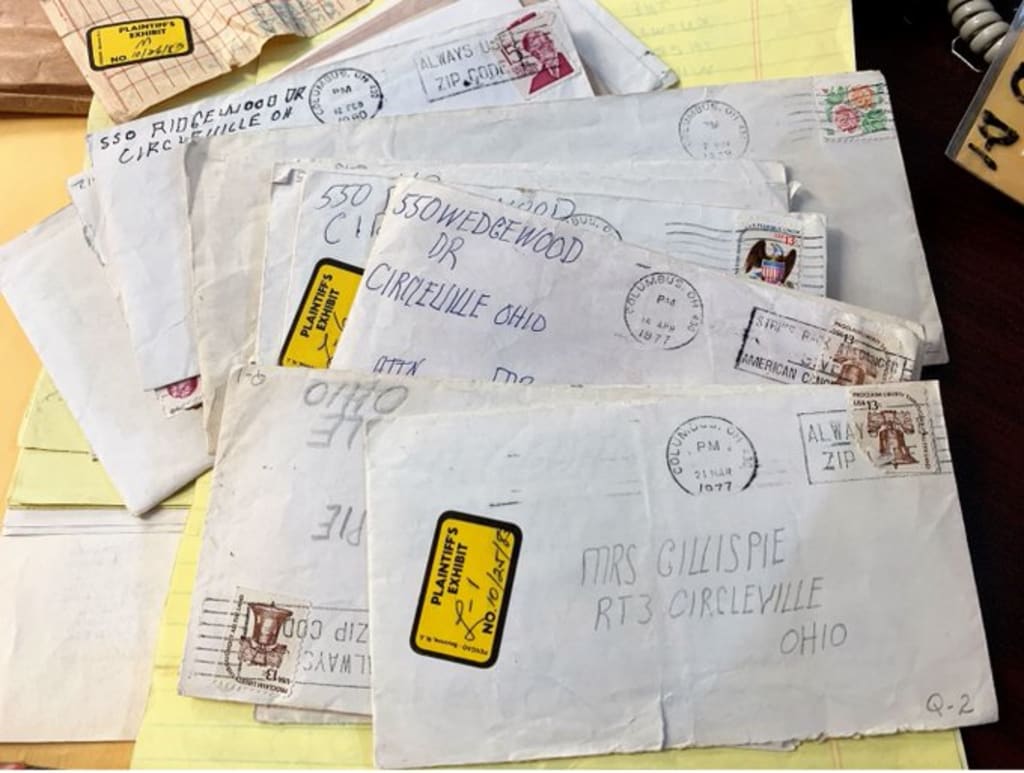The Circleville Letters
A Small Town's Decades-Long Nightmare

In 1976, the tranquil town of Circleville, Ohio, was shattered by a series of anonymous, threatening letters that have continued to haunt its residents for decades. The letters, postmarked from Columbus but devoid of any return address, launched a campaign of terror that focused initially on school bus driver Mary Gillespie. These letters accused her of having an extramarital affair with the school superintendent, an accusation that would lead to tragic and far-reaching consequences.
The malevolent missives did not stop with Mary Gillespie. Her husband, Ron Gillespie, also received a letter. This letter went beyond mere accusation—it threatened Ron's life if he did not take action to stop the alleged affair. The tension escalated to a deadly climax in 1977 when Ron Gillespie died under suspicious circumstances. He was involved in a mysterious one-car crash that also featured gunshots. Despite the oddities surrounding his death, the Sheriff ruled it an accident. This decision did not sit well with the townspeople, and soon, letters began accusing the Sheriff of covering up the truth about Ron's death.
As the letters continued to sow discord and fear, suspicion fell upon Paul Freshour, Ron Gillespie’s brother-in-law. The situation reached a critical point when Mary Gillespie was nearly killed by a booby-trap rigged pistol, an event that pointed investigators toward Freshour. In a controversial trial, Paul Freshour was convicted of attempting to murder Mary via the booby-trap and of writing the threatening letters. He was sentenced to prison, yet the letters did not cease with his incarceration. Incredibly, the Circleville Letters continued to plague the town throughout the late 1970s and into the early 1980s, with Freshour himself receiving one while behind bars.
Freshour steadfastly maintained his innocence, a claim he upheld until his release from prison in 1994 and continued until his death in 2012. Despite numerous investigations and theories, the true identity of the Circleville Letter Writer remains an enduring enigma.
Circleville, a small, tight-knit community, was an unlikely setting for such a protracted mystery. Yet, in 1976, residents began receiving menacing letters that would upend their sense of security. The letters, meticulously crafted and dripping with venom, accused various individuals of heinous acts, with Mary Gillespie and the alleged affair becoming the focal point of the early correspondence.
The writer seemed to possess an intimate knowledge of the town's goings-on, fueling paranoia and suspicion among residents. The letters were not mere threats—they were detailed, specific, and unrelenting. The Gillespie family was particularly targeted, with Ron Gillespie receiving an ominous letter that would ultimately precede his untimely and suspicious death.
The mysterious death of Ron Gillespie marked a turning point in the Circleville Letter saga. On the night of his death, Ron received a phone call that seemed to confirm the letter writer's threats. He left his house with a pistol in hand, only to crash his truck shortly thereafter. The crash was strange enough on its own, but the discovery of gunshot residue added a layer of complexity. Despite these troubling details, the Sheriff declared Ron's death an accident. This ruling did little to quell the growing unease in Circleville, and letters soon began to accuse the Sheriff of a cover-up.
As the investigation continued, suspicion fell on Paul Freshour, the husband of Ron Gillespie’s sister. The pivotal moment came when Mary Gillespie discovered a booby-trap designed to kill her. The trap involved a pistol rigged to fire when the trap was triggered, and the gun was traced back to Paul Freshour. Despite his claims of innocence, Freshour was arrested and charged with attempted murder and for being the author of the Circleville Letters.
The trial was highly publicized and contentious. Evidence against Freshour was largely circumstantial, yet it was enough to secure a conviction. He was sentenced to prison, but the letters persisted even after his imprisonment, casting doubt on whether the true perpetrator had been caught.
The continuation of the letters during and after Freshour’s incarceration deepened the mystery. If Freshour was indeed the writer, how could the letters continue unabated while he was in prison? This question plagued the investigation and kept the town on edge. Freshour's own receipt of a letter while behind bars only added to the confusion and controversy.
Upon his release in 1994, Freshour continued to assert his innocence, maintaining that he had been wrongfully accused and convicted. Despite his appeals and the passing of time, no new evidence emerged to either confirm his guilt or exonerate him conclusively.
Over the years, numerous theories have emerged about the true identity of the Circleville Letter Writer. Some speculate it was a coordinated effort by multiple individuals within the town, while others believe it could have been a single, deeply disturbed person with an intimate knowledge of Circleville's residents and their secrets. The case has been the subject of various investigative reports and true crime shows, each offering different perspectives but no definitive answers.
The Circleville Letters left an indelible mark on the community, fostering an atmosphere of fear and mistrust that lingered for years. The psychological toll on the residents, particularly the Gillespie family and Paul Freshour, was profound. The letters disrupted lives, damaged reputations, and created a pervasive sense of paranoia.
Despite advances in forensic science and investigative techniques, the Circleville Letters remain one of America's most perplexing unsolved mysteries. The case exemplifies how a seemingly simple act—sending anonymous letters—can spiral into a complex web of suspicion, tragedy, and enduring mystery.
The story of the Circleville Letters is a chilling reminder of how secrets and accusations can fracture a community. Decades later, the true identity of the Circleville Letter Writer is still unknown, leaving many questions unanswered. Was Paul Freshour truly guilty, or was he a scapegoat in a larger, more sinister game? What motivated the letter writer to target specific individuals and sow such widespread fear?
As Circleville continues to live in the shadow of this unresolved mystery, the case serves as a stark reminder of the power of words and the enduring impact of unsubstantiated accusations. The Circleville Letters remain an enigma, a puzzle that has yet to be solved, and a story that continues to intrigue and mystify.
About the Creator
Enjoyed the story? Support the Creator.
Subscribe for free to receive all their stories in your feed. You could also pledge your support or give them a one-off tip, letting them know you appreciate their work.






Comments
There are no comments for this story
Be the first to respond and start the conversation.